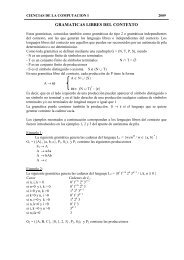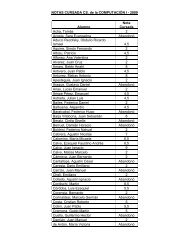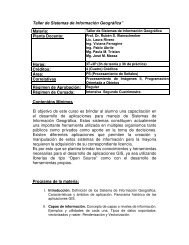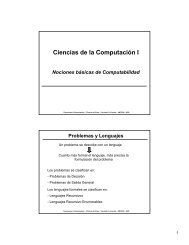Libro de Resúmenes / Book of Abstracts (Español/English)
Libro de Resúmenes / Book of Abstracts (Español/English)
Libro de Resúmenes / Book of Abstracts (Español/English)
You also want an ePaper? Increase the reach of your titles
YUMPU automatically turns print PDFs into web optimized ePapers that Google loves.
Conferencias 15<br />
Immigrant Victims promote Cooperative Relationships: a<br />
Metapopulation Mo<strong>de</strong>l for Variable Interactions<br />
In nature we observe situations in which the outcome <strong>of</strong> the<br />
interaction between two populations may vary <strong>de</strong>pending on the balance<br />
between the costs and benefits associated to the presence <strong>of</strong> the partner<br />
species. In turn, this <strong>de</strong>pends on factors such as population abundances and<br />
environmental conditions. For instance, the interaction between some ant<br />
and homopteran species can be either a mutualism or a predator-prey<br />
association; or regarding pollination a question comes up: is it a mutualism<br />
or a parasitism?; also, a remarkable situation <strong>of</strong> a predator - prey role<br />
reversal between rock lobsters and sea whelks has been reported in South<br />
Africa. These interactions have been labelled variable or conditional<br />
interactions.<br />
Theoretical mo<strong>de</strong>ls have been <strong>de</strong>veloped [1,2] to represent these<br />
associations by means <strong>of</strong> differential equations that inclu<strong>de</strong> <strong>de</strong>nsity<strong>de</strong>pen<strong>de</strong>nt<br />
interaction functions, which result from the net balance between<br />
the costs and benefits involved in the interaction, and which therefore can<br />
take positive and negative signs. The mo<strong>de</strong>l predicts the variation between<br />
types <strong>of</strong> population interactions along the whole continuum <strong>of</strong> beneficial and<br />
<strong>de</strong>trimental associations for each species, <strong>de</strong>pending on factors that are<br />
extrinsic (environmental) and/or intrinsic to the association.<br />
From these results –local, temporal dynamics- I have further<br />
<strong>de</strong>veloped theoretical mo<strong>de</strong>ls that study the dynamics <strong>of</strong> variable<br />
interactions in spatially heterogeneous environments, with particular<br />
emphasis on the analysis <strong>of</strong> variations between victim-exploiter type<br />
associations (parasitism, predation, herbivory) and mutualistic interactions.<br />
I use a metapopulation mo<strong>de</strong>l with locally explicit dynamics computed by<br />
continuous time differential equations, with different migration rates and<br />
different migration routes between patches <strong>of</strong> the environment. The<br />
spatiotemporal dynamics mo<strong>de</strong>l allows us to establish the conditions for the<br />
occurrence <strong>of</strong> a switch from a victim-exploiter to a mutualistic interaction<br />
due to the dispersal <strong>of</strong> individuals between patches. The results show that<br />
this <strong>de</strong>pends mainly on: (i) which species migrate and in which proportions<br />
–in particular the mo<strong>de</strong>l predicts that it is favoured by an increase in the<br />
victim/exploiter proportion within the patch; (ii) the relationship between<br />
the magnitu<strong>de</strong> <strong>of</strong> the <strong>de</strong>nsity-<strong>de</strong>pen<strong>de</strong>nt interaction coefficient within the<br />
patch (local) and the average among patches (global or regional), for each<br />
species in the association; (iii) general <strong>de</strong>nsity-<strong>de</strong>pen<strong>de</strong>nt conditions <strong>of</strong> the<br />
type <strong>of</strong> interaction.<br />
Referecias<br />
[1] Hernan<strong>de</strong>z MJ. 1998. Dynamics <strong>of</strong> transitions between population interactions:<br />
a non-linear interaction α-Function <strong>de</strong>fined. Proc.Roy.Soc.B, 265: 1433-<br />
1440.<br />
[2] Hernan<strong>de</strong>z MJ & Barradas I. 2003. Variation in the outcome <strong>of</strong> population<br />
interactions: bifurcations and catastrophes. J.Math.Biol. 46: 571-594.



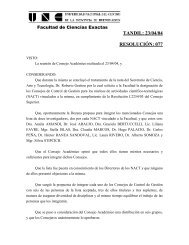
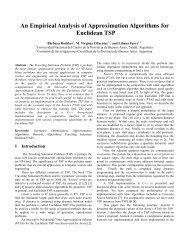
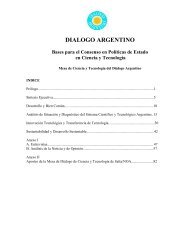
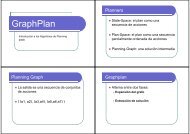
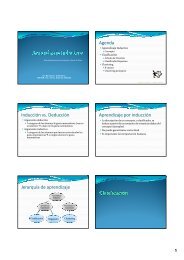
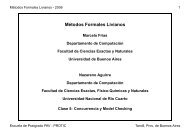
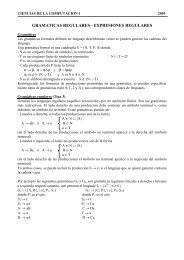

![Clase 13 [pdf]](https://img.yumpu.com/19616969/1/190x245/clase-13-pdf.jpg?quality=85)

